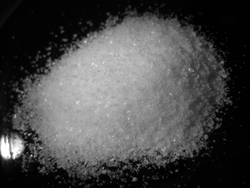Difference between revisions of "Tartaric acid"
| Line 89: | Line 89: | ||
}} | }} | ||
| Section6 = {{Chembox Hazards | | Section6 = {{Chembox Hazards | ||
| − | | AutoignitionPt = 425 °C | + | | AutoignitionPt = 425 °C (797 °F; 698 K) |
| ExploLimits = | | ExploLimits = | ||
| ExternalMSDS = [https://www.docdroid.net/lx7r5RC/l-tartaric-acid-sa.pdf.html Sigma-Aldrich] (levo)<br>[https://www.docdroid.net/9Rs2uN3/d-tartaric-acid-sa.pdf.html Sigma-Aldrich] (dextro)<br>[https://www.docdroid.net/eMhjDGV/dl-tartaric-acid-sa.pdf.html Sigma-Aldrich] (racemic)<br>[https://www.docdroid.net/6w4PpWf/meso-tartaric-acid-monohydrate-sa.pdf.html Sigma-Aldrich] (meso) | | ExternalMSDS = [https://www.docdroid.net/lx7r5RC/l-tartaric-acid-sa.pdf.html Sigma-Aldrich] (levo)<br>[https://www.docdroid.net/9Rs2uN3/d-tartaric-acid-sa.pdf.html Sigma-Aldrich] (dextro)<br>[https://www.docdroid.net/eMhjDGV/dl-tartaric-acid-sa.pdf.html Sigma-Aldrich] (racemic)<br>[https://www.docdroid.net/6w4PpWf/meso-tartaric-acid-monohydrate-sa.pdf.html Sigma-Aldrich] (meso) | ||
Latest revision as of 20:02, 14 January 2020
 Commercially available tartaric acid crystals
| |
| Names | |
|---|---|
| IUPAC name
2,3-Dihydroxybutanedioic acid
| |
| Other names
2,3-Dihydroxysuccinic acid
E334 Paratartaric acid Racemic acid Threaric acid Uvic acid | |
| Properties | |
| C4H6O6 | |
| Molar mass | 150.087 g/mol |
| Appearance | Crystalline solid |
| Odor | Odorless |
| Density | 1.79 g/cm3 |
| Melting point | D-(−)-Tartaric acid 172-174 °C L-(+)-Tartaric acid 170-172 °C racemic 210-212 °C meso-Tartaric acid 165-166 °C |
| Boiling point | Decomposes |
| L or D-tartaric 20.6 g/100 ml DL, racemic 21 g/100 ml meso 125 g/100 ml | |
| Solubility | Soluble in ethanol Poorly soluble in glacial acetic acid, diethyl ether, isobutanol Insoluble in chloroform, dichloromethane |
| Vapor pressure | ~0 mmHg |
| Acidity (pKa) | L(+) 25°C : pKa1= 2.89 pKa2= 4.40 meso 25°C: pKa1= 3.22 pKa2= 4.85 |
| Hazards | |
| Safety data sheet | Sigma-Aldrich (levo) Sigma-Aldrich (dextro) Sigma-Aldrich (racemic) Sigma-Aldrich (meso) |
| Related compounds | |
| Related compounds
|
Potassium bitartrate Succinic acid |
| Except where otherwise noted, data are given for materials in their standard state (at 25 °C [77 °F], 100 kPa). | |
| Infobox references | |
Tartaric acid is a white crystalline organic acid which occurs naturally in many plants, most notably in fruits, such as grapes. One of its salts, potassium bitartrate, commonly known as cream of tartar, is formed naturally in the process of winemaking.
Naturally occurring tartaric acid is chiral, and is a useful raw material in organic chemistry for the synthesis. The naturally occurring form of the acid is dextrotartaric acid or D-(-)-tartaric acid.
Contents
Properties
Chemical
Partial neutralization of tartaric acid with potassium hydroxide or bicarbonate will give potassium bitartrate, also known as cream of tartar. This can be done by mixing equimolar amounts of the two reagents.
- HOOC-CH(OH)-CH(OH)-COOH + KOH → HOOC-CH2-CH2-COOK + H2O
- HOOC-CH(OH)-CH(OH)-COOH + KHCO3 → HOOC-CH2-CH2-COOK + H2O + CO2
Reaction of tartaric acid with hydrogen peroxide in the presence of a ferrous salt will yield dihydroxymaleic acid.
- HOOC-CH(OH)-CH(OH)-COOH + H2O2 → HOOC-C(OH)=C(OH)-COOH + 2 H2O
Tartaric acid can be reduced to succinic acid. A chemical method, which uses hydrogen has been developed. The catalyst used consists of molybdenum oxide supported on carbon black (MoOx/BC). The reaction solvent consists of a mixture of hydrobromic acid and glacial acetic acid. At 170 °C, the yield of this process is 87%.[1]
- HOOC-CH(OH)-CH(OH)-COOH + H2 → HOOC-CH2-CH2-COOH + 2 H2O
Physical
Tartaric acid is a crystalline colorless solid, soluble in water, acids and alcohols, but insoluble in hydrocarbons and halocarbons.
Availability
Tartaric acid is sometimes sold as descaling agent, sometimes mixed with citric acid.
Tartaric acid is available in many winemaking and agricultural stores, though it's more commonly found in the form of potassium bitartrate (cream of tartar) rather than pure acid.
Both racemic and isomeric tartaric acid can be purchased from chemical suppliers.
Preparation
Tartaric acid can be made by acidifying potassium bitartrate, which can be extracted from wine fermentation products (lees) or purchased from the store.
- HOOC-CH(OH)-CH(OH)-COOK + HCl → HOOC-CH(OH)-CH(OH)-COOH + KCl
Projects
- Grow large and beautiful crystals
- Demonstration of chirality in organic compounds
- Make cream of tartar
- Make dihydroxymaleic acid
- Preparation of potassium antimony tartrate
Handling
Safety
Tartaric acid has low toxicity and it's approved as food additive.
Storage
Tartaric acid should be kept in closed plastic or glass bottles. No special storage conditions are required, though it's best to be kept away from light.
Disposal
No special disposal is required. Discard it as you wish.